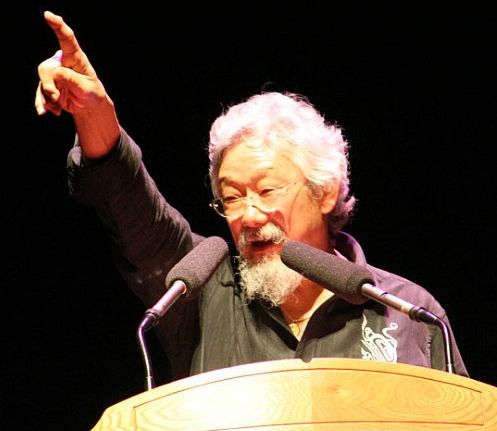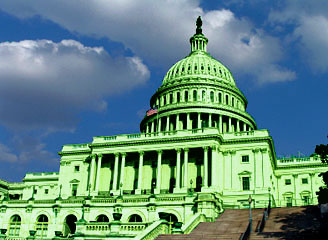House Energy and Commerce Committee leaders released the much-anticipated draft of their climate and energy legislation on Tuesday, a proposal that includes emissions goals more ambitious than those proposed by the Obama White House but also leaves open many of the most contentious questions on climate policy.
Sponsors Ed Markey (D-Mass.) and Henry Waxman (D-Calif.) are calling the 648-page draft bill the American Clean Energy and Security Act of 2009. It calls for reducing greenhouse gas emissions 20 percent below 2005 levels by 2020, 42 percent by 2030, and 83 percent by 2050. The Obama team has put forward a goal of 14 percent cuts by 2020 and 80 percent cuts by mid-century, making the House bill slightly more aggressive.
“This legislation will create millions of clean energy jobs, put America on the path to energy independence, and cut global warming pollution.” said Waxman, chairman of the Energy and Commerce Committee, in a statement on Tuesday. “Our goal is to strengthen our economy by making America the world leader in new clean energy and energy efficiency technologies.”
In a call with reporters today, Speaker Nancy Pelosi (D-Calif.) reaffirmed her commitment to getting a climate bill passed in the House by July, though she also acknowledged that it will be a tough process. The bill, she said, might not get much, if any, Republican support.
“We would hope to have Republican votes as we go forward on this,” said Pelosi. “Will I not put it forth unless I do? No. There’s an inevitability to this that everyone has to understand.”
The bill unveiled by Waxman and Markey would create a cap-and-trade system for carbon dioxide that covers any entity emitting more than 25,000 tons of CO2 per year. The draft language doesn’t include specifics on what percentage of those credits would be allocated to polluters each year at no cost, or how many they’d need to purchase. It also doesn’t specify how the proceeds of an auction would be spent.
Markey told reporters that the plan would most likely include some free allocations of credits, at least in the initial period, and some auctioning. Revenues from carbon auctions would likely be used for consumer rebates and energy investments, he said, but the bill’s authors are leaving the specifics up to committee members.
“That will be determined in our conversations with the members of the committee, and with all other parties who are interested in the issue,” said Markey. “We are firm in our commitment to resolving the issue, but we want to hear from all affected parties.”
The bill currently includes a section drawn from a proposal from Reps. Jay Inslee (D-Wash.) and Mike Doyle (D-Pa.) that would set aside a certain number of allowances for energy-intensive industrial sectors like steel, aluminum, iron, paper, cement, glass, and chemicals and paper, directing the EPA to determine the amount.
The draft also includes several provisions to control the price of carbon credits — leaving a “strategic reserve” of allowances that the EPA could release onto the market if prices rise too quickly, and allowing polluters to “bank and borrow” an unlimited number of credits for future use if they exceed their emissions goals in a given year. It also allows up to 2 billion tons of carbon emission reductions to be met by offsets, which it would split evenly between domestic and international offsets.
Markey acknowledged that the bill largely mirrors the blueprint for climate action put out in January by the U.S. Climate Action Partnership, a coalition of business and environmental groups. USCAP members includes corporations like Duke Energy and Dow Chemical, and environmental groups like the Environmental Defense Fund and the Natural Resources Defense Council.
The Details
The draft includes a number of renewable energy and efficiency provisions. It calls for a renewable electricity standard of 6 percent starting in 2012, scaling up to 25 percent by 2025. It also would create new energy efficiency programs for appliances, support for home energy retrofits, measures to improve building codes, and calls for efforts to improve the efficiency of industrial processes. It also includes measures to spur the use of plug-in electric vehicles.
There’s also a significant electricity transmission component, including efforts to deploy “smart grid” technologies and expanding the capacity to transmit renewable energy. It also directs the Federal Energy Regulatory Commission to craft new grid planning principles.
The bill includes new emissions standards for new heavy vehicles and engines and measures to limit the carbon content of fuels used for motor vehicles, and it would direct the EPA to set emissions standards for airplanes.
The bill would also put in place new emissions standards for coal-fired power plants that come on-line between 2009 and 2015. New plants permitted after Jan. 1, 2015, would need to emit less than 1,100 pounds of carbon dioxide per megawatt-hour of output, and the standards ramp up again for plants approved after 2020. The bill also includes efforts to accelerate progress on carbon-capture-and-sequestration, adopted from a measure put forward by Rep. Rick Boucher (D-Va.), the House’s leading proponent of the technology.
Reactions
Green groups were quick to issue statements praising the draft bill.
“The Waxman-Markey draft bill is a strong start and is testament to their decades of leadership on clean energy and other environmental issues,” said Sierra Club executive director Carl Pope. “We look forward to working with them and other members of the Energy & Commerce Committee in order to flesh out the remaining details and move the strongest possible bill to the House floor … This bill combines the right mix of policies and the long-term vision necessary to build the green economy that will pull us out of the current economic crisis.”
Alliance for Climate Protection CEO Maggie Fox echoed that praise. “Now more than ever, we need a climate and energy policy that moves us past the dirty fuels of the past, embraces strong, science-based targets and quickly reduces emissions of carbon pollution,” said Fox. “We should take advantage of our opportunity this year to transform our economy, create jobs in communities across America and lay the foundation for broad international action on the climate crisis.”
USCAP said the draft bill “provides a solid foundation to create a climate strategy that both protects our economy and achieves the nation’s environmental goals.”
The aggressive schedule for debating the bill drew skepticism from some in the energy sector. “The timeframe for consideration of the legislation will be difficult to meet,” said Scott Segal, director of the Electric Reliability Coordinating Council. “Given the scope and cost of the bill, we hope it will receive a thorough vetting before being passed along for floor consideration. The bill is in need of a range of legislative hearings and full and open mark-ups.”
The folks over at the Competitive Enterprise Institute issued their obligatory statement condemning the idea of cap-and-trade and calling for the bill’s swift defeat. “We will work to see that it dies as quickly as possible,” said CEI Director of Energy and Global Warming Policy Myron Ebell. “Waxman and Markey blithely set targets for reducing greenhouse gas emissions without any serious analysis or even awareness of the colossal costs of energy rationing to American consumers, workers, and industry.”
The Senate’s resident climate change skeptic, James Inhofe (R-Okla.), claimed that the bill does nothing to address climate change, which mind you, he doesn’t believe in. “It appears that this legislation is yet another version of the same story: a job-killing tax increase on American consumers that jeopardizes America’s energy security, while doing nothing to address climate change. In short, it’s all economic pain for no climate gain,” said Inhofe in a statement.
Sen. Barbara Boxer (D-Calif.), who tried to get the Lieberman-Warner Climate Security Act through the Senate last year, said she is “very encouraged” by the House bill. “It is a giant leap forward and I am very excited about it,” said Boxer.
Debate on the bill is expected to begin following the April recess.



